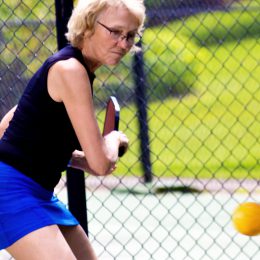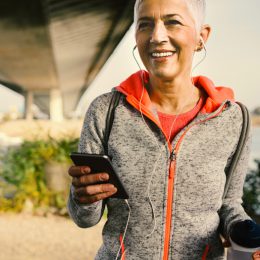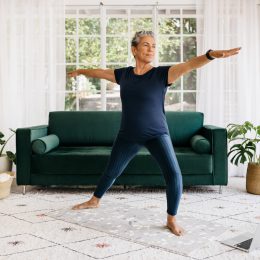Find Your Place: The Longevity Challenge
This one movement can reveal a lot about your overall health, function, and lifespan.
Getting down and back up off the floor is a surprisingly complex movement. And your ability to do so—or not—can reveal a lot about your overall health, mobility, and even lifespan.
Case in point: In a study from the European Journal of Preventive Cardiology, researchers asked more than 2,000 men and women ages 51 to 80 to perform a sitting-rising test. The easier it was for people to lower to a sitting position and then return to standing, the less likely they were to die—from any cause—during the study’s six-year follow-up period.
“Your ability to perform this simple act of daily living relies on muscle strength, flexibility, body composition, and balance,” explains study author Claudio Gil Soares de Araújo, M.D., Ph.D., adding that all of these elements play a role in overall health, function, and longevity.
More specifically, higher levels of strength and muscle mass as well as healthy body fat levels are linked to lower rates of chronic issues such as heart disease, type 2 diabetes, and even cancer, Dr. Araújo says.
Meanwhile, flexibility and balance are both extremely beneficial in the prevention of falls, which are a leading cause of death and disability in older adults, according to the Centers for Disease Control and Prevention.
“Getting onto the ground and getting back up can also be very taxing from a cardiovascular standpoint,” says fitness expert David Jack. “Perform a handful of reps, and your heart rate will get up there!”
That’s the beauty of sitting down and getting back up off the floor. It’s not only a way to assess your overall health and fitness, but it’s a great way to improve it, Dr. Araújo says.
That’s why Jack often uses sitting (or lying) down and standing back up again in his own workouts, as well as in the workouts he creates for his clients.
How to Test Yourself
While the official sitting-rising test that’s used in research settings is a bit more complicated, anyone can perform a simple version at home by simply lowering down and getting back up however you can, if it’s safe for you, Jack says. You could do any of the following:
- Sit up, sweep a leg under, and rise out of a lunge
- Turn over onto your side or stomach, and push up from there
- Cross your legs underneath you, and lift up without the use of your hands
“Do whatever works for you,” says Jack, who recommends trying multiple approaches.
“It’s an opportunity to explore various movement patterns in a low-risk setting to really feel them out and tune in to how your body is moving,” he says. “Maybe you’re able to get up and down, but you feel something in your shoulder or hip. That’s valuable information.”
If you have a chronic condition, an injury, or balance issues, skip the home test, but keep reading for more tips below. Then talk to your doctor about the best way to test your overall fitness—and ask about safe ways you can exercise.
What If You Can’t Do It?
It’s okay! This test is all about providing information and driving self-awareness.
“Not being able to perform the test is simply a piece of information,” Jack says. “And once you know it, you can do something about it.”
If you can’t perform the exercise due to pain or a lack of mobility or strength, Jack recommends talking to your doctor, physical therapist, or personal trainer to help pinpoint the problem and find a solution.
Also, consider which part of the exercise is giving you trouble. Try to perform a few repetitions. Are you losing your balance? Do you experience pain in one or both knees? Can you lower down okay, but rising from a half-kneeling position to standing is a no-go?
Once you identify your problem areas, you can perform exercises that strengthen those movement pattern or skills. For example, if balance is an issue, try adding some—or all—of these six exercises for better stability into your routine.
If the getting up portion is where you stall, maybe you need to perform more lunges or similar lower-body strengtheners, like these six legs and butt exercises you can do while standing.
Subscribe to our newsletter
It's quick and easy. You could be one of the 13 million people who are eligible.
Already a member? Click to discover our 15,000+ participating locations.
Follow Us
Are standing exercises too difficult? Start with sitting exercises like this 15-minute total-body chair workout. Many SilverSneakers classes can also be modified with the use of a chair, and water exercise can be easier on joints.
“Get stronger at each piece of the exercise, and you will get stronger at the whole exercise,” Jack says. “You can also stand near a wall, countertop, or bench, and use it as external support to help you get back up, or put your hand on an elevated yoga block.”
How to Track Your Progress
Jack recommends getting on the floor and rising back up at least once every six months as a way to monitor your overall fitness and function, if it’s safe for you. If something is harder than it once was, that’s a sign that you need to change or supplement your current exercise routine.
If it becomes easier—or you are now able to stand up in 10 different ways as opposed to five—then your workout is obviously working.
“This can be hugely validating,” Jack says. “Give yourself a pat on the back.”
Performing this movement every six months is Jack’s minimum recommendation. You can perform it much more frequently—every week or even every day, he says.
If you find it challenging, it can be a great tool for building total-body strength. And if you find it easy, it can be a great warmup exercise to help activate and mobilize your muscles before a workout. You can also make the exercise harder by performing all or parts of it with a sandbag, kettlebell, or medicine ball.
Assess your fitness, use that information to inform your training, and you can expect great things, Jack says.
Check Your SilverSneakers Eligibility Instantly
SilverSneakers gives you free, unlimited access to more than 15,000 gyms and fitness centers across the nation, plus classes and tools designed to keep older adults strong and independent. Check your eligibility instantly here. Already a member? Get your SilverSneakers member ID and exclusive content by logging in to or creating your online account here.





